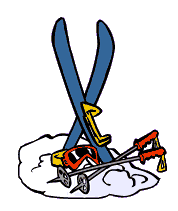Snow Skiing
 Skis. Are your skis the right size? If the tip of your upright ski reaches your face between your nose and chin, they are. If you're a beginner, shorter skis will be easier to control. The bindings (the part that holds your boot to the ski) are the most important parts of the ski — to make sure they don't break, get them tested regularly by a pro.
Skis. Are your skis the right size? If the tip of your upright ski reaches your face between your nose and chin, they are. If you're a beginner, shorter skis will be easier to control. The bindings (the part that holds your boot to the ski) are the most important parts of the ski — to make sure they don't break, get them tested regularly by a pro.
Make sure your boots fit and are comfortable. In general, ski boots are 1/2 size smaller than your normal shoe size.
Ski Helmets. Be a trendsetter by picking up the helmet habit. Choose an ASTM approved model that fits right, is ventilated, and doesn't affect your hearing or field of vision.
Ski Poles are used to give you balance and help you get up if you fall, or need to side-step up a hill.
Goggles are important to protect your eyes from flying dirt or snow, as well as stopping the sun's glare while whooshing down the slopes. Some goggles come with fun tinted lenses. If you don't have goggles, you can use sunglasses instead.
If you are renting equipment, the staff at the ski shop can help you find all the right stuff.
Stay Warm on the Slopes
Check out more info on snow skiing!
 Skis. Are your skis the right size? If the tip of your upright ski reaches your face between your nose and chin, they are. If you're a beginner, shorter skis will be easier to control. The bindings (the part that holds your boot to the ski) are the most important parts of the ski — to make sure they don't break, get them tested regularly by a pro.
Skis. Are your skis the right size? If the tip of your upright ski reaches your face between your nose and chin, they are. If you're a beginner, shorter skis will be easier to control. The bindings (the part that holds your boot to the ski) are the most important parts of the ski — to make sure they don't break, get them tested regularly by a pro.
Make sure your boots fit and are comfortable. In general, ski boots are 1/2 size smaller than your normal shoe size.
Ski Helmets. Be a trendsetter by picking up the helmet habit. Choose an ASTM approved model that fits right, is ventilated, and doesn't affect your hearing or field of vision.
Ski Poles are used to give you balance and help you get up if you fall, or need to side-step up a hill.
Goggles are important to protect your eyes from flying dirt or snow, as well as stopping the sun's glare while whooshing down the slopes. Some goggles come with fun tinted lenses. If you don't have goggles, you can use sunglasses instead.
If you are renting equipment, the staff at the ski shop can help you find all the right stuff.
Stay Warm on the Slopes
- Long underwear to keep you warm and absorb sweat.
- Insulated tops and pants such as sweaters and leggings — this layer should be warm, but not baggy.
- Ski pants and jackets to protect you from snow and wetness.
- A hat, because 60 percent of heat loss is through the head.
Check out more info on snow skiing!